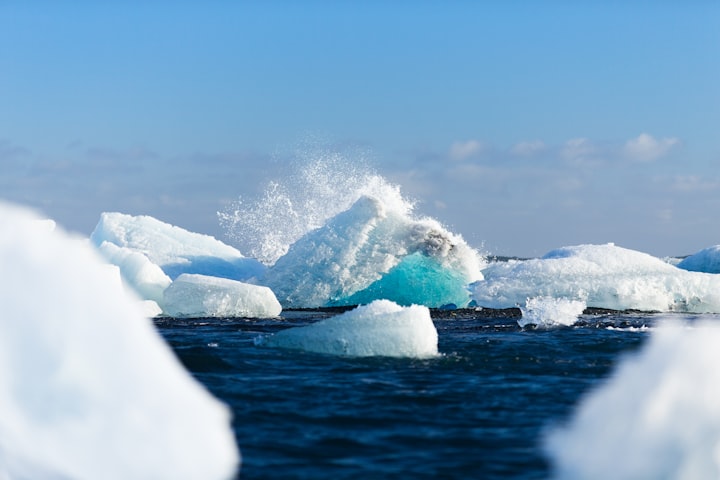Freeze the Earth's oceans? A piece of "No. 7 ice" is enough. What exactly is "No. 7 ice"?
To "squeeze" the diamonds out of the water and freeze the whole ocean quickly, this is something that ice No. 7 can do.

The ice cubes or ice crystals we commonly see are a structure of positive hexagonal arrangement, where the oxygen atoms' are recombined and the ice expands.
Whether it is frost on the ground in winter or snow falling from the sky, even ice made in an ice machine is no different from them.
This type of ice is called ice-Ih in "Bridgman" nomenclature, where h refers to the hexagonal structure of the oxygen atoms as they transform from liquid or gas to solid ice.
However, this square structure is not the only shape in which water molecules can be aggregated; theoretically, under the right pressure and temperature, the crystalline phase of water can take on 17 different styles.
Of course, there is also the hotly discussed No. 18 ice in recent years.
In terms of conventional No. 1 ice, the temperature and pressure of the Earth do not vary much, so No. 1 ice is also the most abundant ice crystal we can see.
As long as the pressure and temperature continue to be properly applied to the ice crystal, its phase state will change in a particularly strange way.
Ice #7 is unique in that it remains stable even when the pressure increases dramatically.
Ice #7 would also be 1.5 times denser than ice #1, although the Earth's environment clearly does not allow it to occur properly.
Because to form No. 7 ice, it needs more than 30,000 atmospheres of pressure, that is, 3 gigapascals of low temperature state.
The only possible place in the Earth where No. 7 ice can be formed is the mantle, but the temperature in this location will be so high that No. 7 ice cannot be formed here.
From ice #2 to ice #18, scientists have now been able to produce this strange ice crystal in the laboratory with different temperatures and pressures.
From molten solids, to boiling liquids, to sublimated solids to supercooled liquids or superheated liquid-gas mixtures.
Extremely pure supercooled water can remain liquid below 0°C until a vibration is applied or condensate doping triggers crystallization.
No. 7 ice is sub-stable over a wide range of temperatures and pressures and can transform to low-density amorphous ice above -153°C.
The molecular arrangement of amorphous ice lacks long-range ordering, and it is produced either by rapid cooling of liquid water, which leaves the molecules too late to form a lattice, or by low-temperature compression of ordinary ice.
Alternatively, #7 ice can be formed in a few nanoseconds by the rapid compression of a shock wave, or it can be produced by increasing the pressure of #6 ice at ambient temperature.
As with most ice phases, the hydrogen atoms are disordered in their positions and the oxygen atoms are disordered in multiple positions.
The structure of No. 7 ice contains a hydrogen-bonding framework, which behaves as two interpenetrating but unbonded sublattices.
The hydrogen bonds cross the center of the water hexamer and therefore do not connect the lattices. Among all ice phase states, No. 7 ice is the only disordered ice phase that can be ordered by simple cooling.
In addition, No. 7 ice has the largest stability field of any molecular phase of ice, and the cubic oxygen sublattice that forms the structural skeleton of No. 7 ice persists at a pressure of at least 128 gigapascals.
High-tech ice creation
Research and theoretical work on No. 7 ice has shown that it can be synthesized in the laboratory.
In 2017 Stanford University, California, in conjunction with Los Alamos National Laboratory, New Mexico, scientists successfully observed the formation of No. 7 ice under a shock of laser pressure.
Scientists fired a powerful X-ray laser into a vial of water and then used another powerful laser pulse to take a high-speed picture.
This allowed the scientists to see the molecules in the water rise one by one into the ice phase of No. 7 ice.
Although scientists have tried to create No. 7 ice before, they have not succeeded in capturing the freezing process.
In this 2017 experiment, scientists were able to capture the formation of No. 7 ice, which takes only 6 nanoseconds to freeze quickly.
The scientists analyzed the diffraction peaks of the No. 7 ice formation process based on fitting the time dynamics of the diffraction peaks over time.
The team concluded that during freezing, water first crystallizes into needles and a bunch of rod-like structures, and then nucleates to form solid No. 7 ice.
In general, substances are somewhat compressible.
As more and more pressure is applied to the solid phase of a substance, the space between the chemical bonds decreases slightly and they tilt slightly apart.
But water ice has very little compressibility, and when it is subjected to too much pressure, the atoms do not clump together.
Instead, they rearrange themselves into other different patterns, depending on the pressure and the specific environment.
For example, if pressure is applied to ice #1, it becomes ice #2 with a rhomboidal structure, and if pressure is continued, other ice phases are formed.
Unlike the other ice phases, however, the phase of ice #7 remains stable even if the pressure continues to increase.
Scientists believe that there could be a large amount of No. 7 ice in the solar system, and it could appear inside icy moons like Titan and Europa.
Or, it would be part of Titan's oceans, but it certainly would not occur naturally in the Earth.
As we said earlier, the mantle is the only place where No. 7 ice could potentially exist, but the temperatures there are too high to form No. 7 ice.
However, scientists have found new evidence in a new study of diamonds generated from the mantle.
Due to the special nature of diamonds, small amounts of the material can also be formed naturally in the Earth.
Diamonds deep in the mantle are buried more than 600 kilometers below the Earth's crust, and as they form they occasionally capture a small fraction of the surrounding chemical environment, which then seals them inside.
Ice diamond No. 7
In a 2018 study of water-bearing fluids in the mantle, scientists believe that water-rich regions in the mantle play a key role in global water expenditure and the flow of heat-producing elements.
Related studies have shown that ice #7 can occur in natural diamond inclusions, which can serve as an indicator of such water-rich regions.
Studies of olivine and rock minerals in the deep mantle have shown that
The average abundance of chemically bound water in different regions of the Earth, and the possible location of smaller layers or water-rich rock melts, help scientists to understand the Earth's water activity within extended geological events.
The presence of Ice-VII in diamonds, on the other hand, is the best evidence for the presence of aqueous fluids around the transition zone-lower mantle boundary.
A study of the number of occurrences of ice inclusions No. 7 in diamond by X-ray diffraction reveals that ice No. 7 is mixed in diamond with other micron-sized detritus.
During nucleation, a small number of atoms or molecules in the fluid or vapor are arranged in a characteristic arrangement of crystalline earth solids, which then form a site.
As the crystal continues to grow, more particles are deposited in that location until it is completely frozen.
Ice-VII forms in the mantle in two different ways, with nucleation starting at some kind of surface.
Then diffusion inward is "heterogeneous" formation, and "homogeneous" indicates that the ice forms in most water samples, which freezes all water samples almost instantly.
Scientists have also shown that the temperature difference between liquid water and the forming ice crystals, in addition to a specific threshold or threshold determines whether the ice nuclei are homogeneous or non-homogeneous.
So the whole process in short, the mantle is at high temperature and pressure where the diamonds will form.
After the water bubble is wrapped in the diamond, as the water gradually rises to the surface, the water is then exposed to a lower temperature, yet the diamond's steady state remains at high pressure.
Even if No. 7 ice is present in the high-pressure state, if it is not above a specific threshold, nucleation will diffuse inward.
Once this threshold is exceeded nucleation diffuses throughout the sample when a rapid phase transition occurs.
So, ice can form and diffuse so quickly that the nascent ice crystals and the surrounding water must be at different temperatures for this rapid freezing to occur.
Scientists say that the unusual way in which No. 7 ice is generated in the mantle starts out as tiny clusters of about 100 molecules and then grows extremely fast at speeds of more than 1,600 kilometers per hour.
If No. 7 ice appeared in this form, it could quickly freeze all of Earth's oceans. But this is rare and does not occur on Earth.
In the case of a meteor or comet blast, the shock wave from the explosion would be enough to compress any water to just the right amount of high pressure so that it could form No. 7 ice in deep enough waters and then quickly spread to the surface.
Scientists are currently pondering the effects of No. 7 ice on exoplanets and its distribution in planetary systems, and in the future it will shed further light on planetary evolution for us.
About the Creator
Turnell Feliu
People who shiver from the cold can best appreciate the warmth of the sun. Those who have experienced life's troubles know best the preciousness of life






Comments
There are no comments for this story
Be the first to respond and start the conversation.